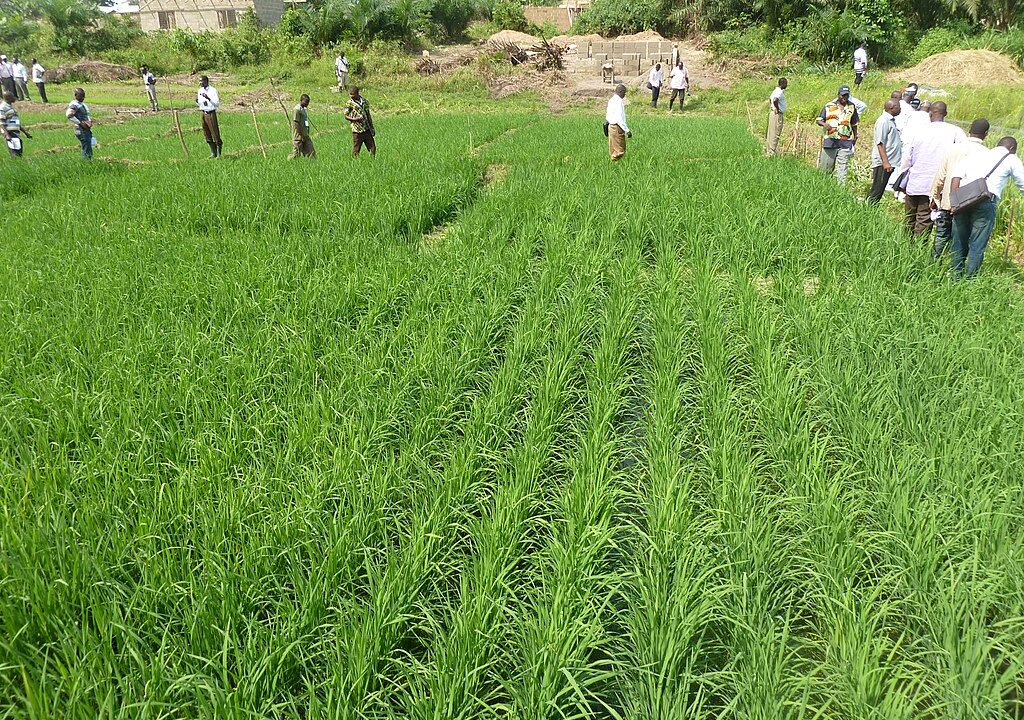The AfDB Sides With the Agrochemical Industrial Complex
Against the wishes of hundreds of millions of farmers, the African Development Bank is backing a model that can cause economic dependence, soil depletion and pollution. Sawah rice cultivation in inland valleys in Ashanti region, Ghana by Africa Rice Center via Wikimedia Commons / CC BY-SA 3.0
Sawah rice cultivation in inland valleys in Ashanti region, Ghana by Africa Rice Center via Wikimedia Commons / CC BY-SA 3.0
After the largest food price spike in recent decades, 2022 was dubbed the “year of unprecedented hunger.” Africa was once again at the forefront of the catastrophe, with hundreds of millions suffering from severe food insecurity.
In May that year, the African Development Bank (AfDB) launched a $1.5 billion African Emergency Food Production Facility with the stated goal of boosting food and nutrition security on the continent. This strategy is largely geared towards expanding an industrial model of agriculture centred on monocropping and increased reliance on inputs such as “improved” seed and chemical fertiliser.
To boost food production—with a focus on wheat, corn, rice, and soybean—the facility is to deliver “certified seeds, fertilizer and extension services to 20 million farmers” and provide “financing and credit guarantees for large-scale supply of fertilizer to wholesalers and aggregators”. Additionally, and in a concerning echo of Structural Adjust Programmes, the AfDB also announced that it is working to “secure commitments from African governments on implementing policy reforms on fertilizer”, after consulting with “fertilizer company CEOs.”
Is this approach what African farmers want or need amidst shifting precipitation patterns, rising temperatures, and more extreme weather?
Framed as a crisis response, this corporate-led strategy has actually been at the core of the AfDB’s agenda for years. Its Strategy for Agricultural Transformation in Africa (2016-2025), for instance, seeks to expand the use of commercial inputs and liberalise input markets. Meanwhile, through its Africa Fertilizer Financing Mechanism, the AfDB has worked closely with the Alliance for a Green Revolution in Africa (AGRA) and the International Fertilizer Development Center as well as controversial corporate giants like Syngenta, Yara, Dangote, Export Trading Group, and Omnia Fertilizer.
Is this approach what African farmers want or need amidst shifting precipitation patterns, rising temperatures, and more extreme weather? Is it compatible with the AfDB’s commitment to support a “transition [of] food systems compatible with climate and biodiversity imperatives”? Who truly benefits from this agenda?
According to the AfDB, the use of fertilisers and “improved” seeds increases agricultural productivity, leading to “a huge impact on [farmers’] yields, and therefore on their income”. This notion, however, ignores the vicious cycle that reliance on chemical fertilisers leads to. As research has shown, synthetic fertilisers can deplete the land’s nutrients, meaning more and more fertiliser is needed each year to produce the same yields. This creates a dead-end in which farmers have to spend more on inputs year on year, food security doesn’t improve, and the soil loses fertility over time.
This strategy can also prove extremely expensive for countries that subsidise synthetic inputs, a common intervention of many governments on the continent. At one point, for instance, Malawi was spending 16% of its entire government budget on a farm input subsidy programme that failed to reduce hunger. The costs of these kinds of subsidies may only increase; chemical fertiliser prices reached near record levels in 2022 and are projected to remain high for several years.
As well as being ineffective and costly, the use of chemical fertilizers also devastates the environment. The supply chain for synthetic nitrogen fertilizer is responsible for 2% of all global emissions. Meanwhile, runoff of nitrogen and phosphorus lays waste to local water supplies through algal blooms. These impacts are so serious that experts have called the flood of excess nitrogen into the environment “one of the most severe pollution threats facing humanity today.”
Across the continent, organizations representing hundreds of millions of African farmers strongly oppose this Green Revolution model of large-scale, monocrop production reliant on chemical fertilizers.
Agrochemical corporations have made record sums during the recent crisis as the prices of nitrogen, phosphate, and potash skyrocketed. For instance, Canada’s Nutrien took in a record $5 billion in net earnings in the first half of 2022. Norway’s Yara International reported a first-quarter operating income of $1 billion, more than triple the same figure a year earlier. US company Mosaic saw its earnings per share grow by over 250% in the same period, while Germany’s Bayer boasted “outstanding sales and earnings growth, with particularly substantial gains for our agriculture business.”
Fertilizer companies have a history of thriving in times of hunger. As detailed in a report from the NGO INKOTA, top fertilizer companies captured colossal profits during the last food price crisis in 2007/8, which they then used to consolidate and expand their power.
Today, agrochemical companies see Africa as the last expansion market. While an average 135kg of fertilizer is applied per agricultural hectare globally, that figure in sub-Sahara Africa is just 17kg. On the continent, smallholder farmers have been feeding hundreds of millions of people with little need for chemical fertilizers or so-called “improved” seeds. Entrenching a greater reliance on commercial inputs for African farmers is thus seen as a major opportunity for business growth.
Across the continent, organizations representing hundreds of millions of African farmers strongly oppose this Green Revolution model of large-scale, monocrop production reliant on chemical fertilizers. The Alliance for Food Sovereignty in Africa (AFSA) and many other networks of farmers reject these programs and have urged governments and international institutions to instead support a move to sustainable and climate-friendly methods.
This starts with the rehabilitation of African crops, such as teff, sorghum, fonio, amaranth, millet, cassava, yam, and many others. While Indigenous plants have assumed a reputation as “food for the poor” due in large part to ideas engrained during colonial rule, they are central to the diet of hundreds of millions of people. These crops are adapted to local geoclimatic conditions, which makes them more resilient to climatic shocks and less reliant on inputs than foreign cereals. By using agroecological systems that nurture healthy ecosystems, these crops can form part of a wide diversity of crops – alongside cereals, vegetables, roots, tubers, nuts and fruits—to provide a range of socio-economic, nutritional and environmental benefits— unmatched by monocrops.
Instead of doubling down on a failed model, now is the time to direct public funds to support the solutions that African farmers are calling for across the continent.
Building on Indigenous knowledge, millions of farmers across Africa have assembled an abundance of effective practices and innovations that don’t require costly and polluting inputs. In Kenya, fermenting organic matter to create a nutrient rich compost called Bokashi is helping farmers restore dry, depleted soils. Farmers planting nitrogen-fixing “fertiliser trees” in Malawi are benefiting from the high levels of biomass they create and the nutrients they capture as well as their resilience to drought. A variety of nitrogen fixing leguminous plants are widely used from Malawi to Benin. And in many countries—including Senegal—cover crops are planted to protect the soil and improve the fertility through increased nutrient retention. Coupling such practices with composting, farmers across the continent have seen drastic yield increases. Mixing plants, crops, and trees also makes communities more resilient to the climate crisis by providing different sources of food and income along the year.
These are just some of the many impactful agroecological practices that are backed by scientific studies. This growing body of research – along with centuries of experience—demonstrates that alternatives to chemical fertilizers are effective, affordable, and sustainable. Moreover, unlike synthetic inputs, these approaches restore the soil over time and are unaffected by erratic global price spikes.
These practices are not just solutions to hunger. They are also essential for a shift towards resilient, environmentally sustainable farming. Yet they will remain neglected and underfunded as long as corporate bottom lines are prioritized by international finance institutions such as the AfDB. Instead of doubling down on a failed model, now is the time to direct public funds to support the solutions that African farmers are calling for across the continent.
Your support matters…Independent journalism is under threat and overshadowed by heavily funded mainstream media.
You can help level the playing field. Become a member.
Your tax-deductible contribution keeps us digging beneath the headlines to give you thought-provoking, investigative reporting and analysis that unearths what's really happening- without compromise.
Give today to support our courageous, independent journalists.






You need to be a supporter to comment.
There are currently no responses to this article.
Be the first to respond.